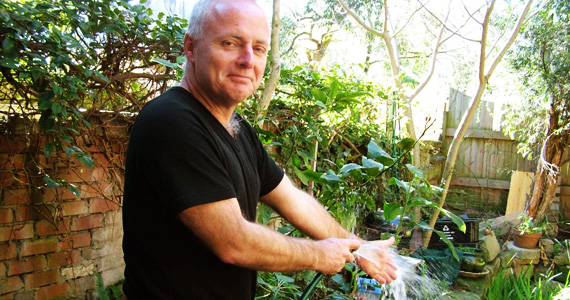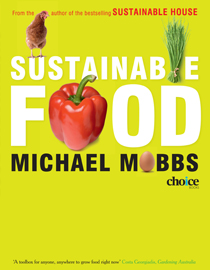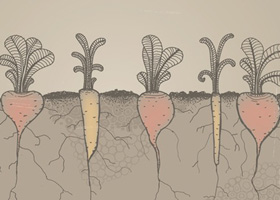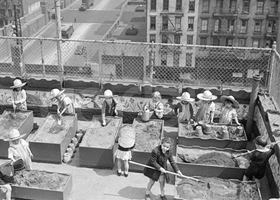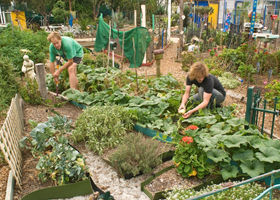Michael Mobbs talks sustainable food
Environmental lawyer, consultant, urban farm designer and all round sustainability guru, Michael Mobbs attracted Australian and international attention when he converted his small inner city house into a water collecting, energy generating, waste water/sewage reusing residence. The following article is an extract from Michael Mobbs’ new book, Sustainable Food.
Call me a gardener.
I live in Chippendale, Australia. It’s a small, closely built suburb with about 4000 residents and 4000 workers, a 40-minute walk from the Sydney Opera House and the Harbour Bridge.
In 2010 I saw a young fellow crouching on the road verge gathering ‘weeds’ and placing them with surprising care into a plastic container. ‘I’m making a salad,’ he said. ‘And I’d like to come gardening with you.’ When he emailed me later I saw he was a head chef in a famous restaurant (Luke Powell, Tetsuya’s) and he lived around the corner. If there were no road gardens in Chippendale I guess Luke and I may never have met. And I may never have learnt to harvest ‘weeds’ to make salads.
Stories like this are what my book Sustainable Food is about. How I had the good luck to have that accidental eye-opening conversation in the street – how I came to see these are the real fruits of a self-renewing society, that gardening brings with it opportunities to reconnect with ourselves and our neighbours, not just plants and our bellies.
I took the long way round before I understood: such conversations with strangers may truly sustain us.

Later, in my 19 years as a specialist environmental lawyer I learnt to deal with local councils and government agencies. I realised if I wanted change I had to do things myself; to build real projects that showed we can do what so many laws, governments and policy-makers say we citizens can’t do. And teaching law at Sydney University of Technology’s schools of Law and Engineering gave me a chance to learn from students about how they see and use the law and, in turn, how they see the uses they may make of Earth’s land, water, energy and other resources.
In 1996 I disconnected my inner city terrace from mains water and sewer and put in solar panels. It hadn’t been done before in the city. For the last 16 years the house has been getting its water from the rain and its energy from the sun. I wrote a book about it, Sustainable House, which has sold over 50,000 copies. The house now has a life of its own: it attracts media, political and citizen interest from around the world. I’ve learnt that projects bring change faster than policies and laws.
After finishing the house and gardening with re-used water from it, I noticed how much of this precious resource was needed to grow things. Easily more than the rainwater for my shower. And my work coaching developers, architects, engineers, real estate agents and builders to build sustainable offices, houses, units and subdivisions obliged me to get the facts about energy and water. About four years later, around 1999, I found data which proved my house was sustainable, but I wasn’t.
Yes, the house saves over 100,000 litres of dam water a year. But to eat 10 days of food the average Australian needs over 100,000 litres of water to produce it.
It’s the house that’s sustainable. Not me.
The house only delivers water for cooking, washing and cleaning. That’s less than a thirtieth of the water we need to grow, transport, clean, cook and waste our food.
Food for my tummy needs more energy and water than my house. Look at an Olympic-sized swimming pool (50 metres long, 10 lanes wide). That’s how much water we need each year to grow one Aussie’s tucker. Sydney has over four million people, and their tummies need four million swimming pools of water.

Once the water and energy needs for food became clear the real meaning of ‘sustainable’ hit me. If I grow and buy my food where I live and work – using only local soil, seeds, fertiliser and plants – I’m mostly on the way to being sustainable. I’ll be sustainable when my need for food – for my body, and the needs of my house – are met where I am. When I live like a tree which gets all its food, water and energy and all it needs where it is – then I’ll have achieved the balance I seek.
Except for food, these resources are here freely, naturally: the energy and water that falls on the roof of the house or the plants. And, just as the dropped leaves and branches from a tree or vegetation become soil so, too, is any wasted food turned into soil by composting. Nature produces no waste; so it can be in the city. There is no such thing as ‘waste’, just a failure of imagination. An indicator of a sustainable suburb will be one where garbage trucks are no longer needed.
Click here to read the continuation of this article. You can find further information about Michael and sustainable eating on his website.
Michael Mobbs’ new book Sustainable Food is published by Choice Books [Nov 2012], rrp $45.


